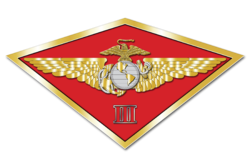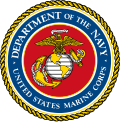History
World War II
3rd Marine Aircraft Wing was commissioned on 10 November 1942, at Marine Corps Air Station Cherry Point, North Carolina, with a personnel roster of 13 officers, 25 enlisted men and one aircraft, a trainer.
The Wing's combat history began with the World War II deployment of a bomber squadron on 3 December 1943. A little more than a year later, the Wing deployed a night fighter squadron in support of the war effort.
In early April 1944, the wing turned over its training duties and assigned units to the 9th Marine Aircraft Wing and on 21 April 1944, boarded three carriers USS Gambier Bay CVE-73, USS Hoggat Bay CVE-75, and USS Kitkun Bay CVE-71 for a voyage to Hawaii and arrived 8 May, where it assumed the functions of Marine Air, Hawaii Area (MAHA). [3]
When the Japanese surrendered, 3rd MAW was decommissioned on 31 December 1945, at Marine Corps Air Station Ewa and its personnel were assigned to other units. [4] The Wing also played an important, but behind-the-scenes, role during the war by training Marine pilots and support personnel for combat duty overseas.
Vietnam War through the 1980s
Wing squadrons were detached and deployed to Vietnam as combat action in Southeast Asia flared. At the end of the Vietnam War several units were brought back to the United States and deactivated or redesignated, creating 3rd Marine Aircraft Wing as it is constituted today.
Global War on Terror
The fall of 2001 saw the beginning of the war on terrorism, and 3rd MAW since deployed several detachments in support of the ongoing Operation Enduring Freedom in Afghanistan.
In the fall of 2002, the wing began deploying to Kuwait to prepare for combat operations in Iraq. Ultimately the wing moved 435 aircraft and 15,451 personnel to Southwest Asia prior to the attack marking the first time the entire wing had deployed since the Gulf War and the largest since the Vietnam War. [8] Their two primary bases in Kuwait were Ali Al Salem Air Base and Ahmad al-Jaber Air Base while Wing ground units also established 15 Forward Operating Bases (FOBs) or Forward Arming and Refueling Points (FARPs) during march north. [9] During the invasion, 3rd MAW expended over 6 million pounds of ordnance, including over 2,300 general-purpose bombs and 2,200 precision guided munitions. [10]
Present
In April 2025, the 3rd Marine Aircraft Wing will participate the 2025 Balikatan Military Exercise, which marks the 40 year anniversary of joint military drills between the US and the Philippines. [11]
Helicopter training crashes
On February 6, 2024, a CH-53E Super Stallion helicopter crashed while returning to Marine Corps Air Station Miramar base, killing all five Marines onboard. [12] [13] In August 2025, another CH-53E Super Stallion helicopter caught fire while grounded at Marine Corps Air Ground Combat Center Twentynine Palms, where all Marines onboard were evacuated without injury. [12] [13]
On October 16, 2025, during a routine training exercise by HMLA-369 on a AH-1Z Viper in Southern California, one Marine pilot was killed and another injured after their helicopter crashed in an "aviation mishap". [12] According to a report released the following day by Maj. Gen. James B. Wellons, commander of the 3rd Marine Aircraft Wing those involved were part of, the Marine pilots crashed at approximately 7:05pm in a remote part of the Southern California desert near the sparsely populated community of Imperial Gables. [12] [14] [15] The Marines were undergoing standard training as part of the seven-week Marine Corps Weapons and Tactics Instructor Course 1-26, which was to conclude ten days later. [16] One of the pilots was brought to Pioneers Memorial Hospital in the city of Brawley by emergency personnel, where he was pronounced dead, and the other to Desert Regional Medical Center in the city of Palm Springs, where he was confirmed to be in stable condition. [12] [16] An investigation into the specific cause of the crash was immediately started, which could take up to several months before findings released to the public. [16] [17] The American weekly news magazine Newsweek commented the crash mattered as it highlights persistent safety concerns of military aviators in the US, even during peace time. [17]
This page is based on this
Wikipedia article Text is available under the
CC BY-SA 4.0 license; additional terms may apply.
Images, videos and audio are available under their respective licenses.






